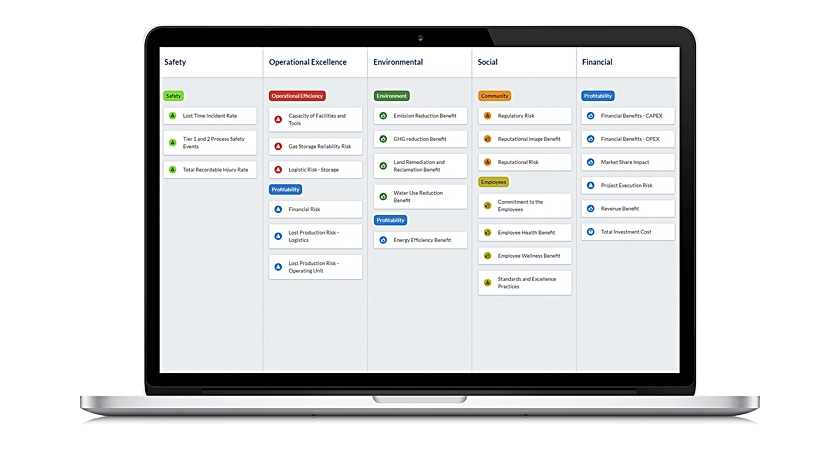Striking the Balance: Decision Analytics for Future-Proof Investment Planning in Oil and Gas
In the first article of this series, we explored the challenges and high-consequence decisions facing the global oil and natural gas sectors. In this piece, we explore how Copperleaf’s decision analytics solutions can be used to develop and execute investment strategies that maintain profitability while continuing to deliver safe, reliable energy to consumers around the world.
Moving Beyond Outdated Planning Methods
Smart, consistent, and agile investment plans will be at the center of any successful oil and gas business strategy. Over the last few years, an industry that has survived and thrived for a century using time-tested planning methods and business models found itself dealing with post-pandemic volatility in supply and demand, geopolitical turmoil with global ramifications, and increasing calls for action to combat climate change. As a result, companies have to reassess and adapt investment plans quickly and confidently to meet rapidly changing circumstances. With trillions of dollars and thousands of projects to manage, this level of decision-making and investment optimization falls well outside the capabilities of business-as-usual planning tools and spreadsheets.
Redefining Value for a New Era
A recent McKinsey report predicts demand for global fossil-fuels will peak between 2024-2027, and renewables will account for 80-90% of power generation globally by 2050. Today, organizations across the oil and gas sector are seizing the opportunity to reinvent. Many companies are transforming investment portfolios to deliver on newly defined long-term objectives for the environment and the community—while maintaining the safe, affordable, and reliable services that consumers and partners expect.
With so many factors to consider, reviewing competing investment candidates is no longer an “apples to apples” exercise. Where historically an investment’s relative value could be determined using financial and reliability metrics, today new Environmental, Social, and Governance (ESG) factors—and the reputational repercussions of decisions—must be considered.
Expanding and embedding this concept of “value” across the business units of an organizations is central to making decisions on a common economic scale. This enables companies to manage the trilemma of energy security, while positioning for growth and maximizing profits.
Optimizing and Re-optimizing Plans in a Changing World
In 2020, the global pandemic resulted in a severe and rapid drop in energy demand. As countries and companies reopened, demand returned but supply lagged, leading to price spikes and market volatility.
The conflict in Ukraine has again brought to the forefront supply security and affordability issues. While the largest oil and gas companies in the world reported record profits in the first half of this year, fears of a potential recession and other factors have contributed to lower energy prices since the close of Q2, making it unlikely that the sector’s profits will maintain the same pace. At the same time, the oil and gas industry is facing the same severe supply chain and workforce issues that all industries around the world are suffering.
The global energy landscape has been impacted by increased market uncertainty due to the conflict in Ukraine. Already before the conflict began, the rebound in energy demand triggered supply constraints and price spikes for multiple commodities. Additionally, the long-term shift to low-carbon energy systems continues to gain momentum and has been accelerating in several respects.
McKinsey
Global Energy Perspective 2022
With circumstances changing so rapidly, organizations across the oil and gas sector must adapt investment plans made during more stable times to contend with the challenges of today and tomorrow.
What if budgets are reduced by 15%? What if oil prices drop significantly? What if the organization wants to accelerate greenhouse gas reduction targets?
Addressing these questions by re-optimizing investment plans in a consistent and effective way requires a more sophisticated approach than manual methods and spreadsheets.
Building Trust for a Better Future
Oil and gas companies across the globe are adopting different strategies to future-proof their businesses, directing investment to new technologies and innovation to reduce and capture carbon emissions, diversifying portfolios to increase renewables, and upgrading existing infrastructure to perform cleanly and efficiently. But no company has the funding or resources to do it all immediately and hard choices must be made.
Under intense scrutiny from both inside and outside the organization, it is crucial for oil and gas companies to demonstrate how their investment choices will impact communities, the environment, and the bottom line to gain the trust of government, investors, consumers, and employees.
…this is a moment for oil and gas companies to make thoughtful choices: both to improve their economic and reputational resilience, and to consider whether and how to reposition themselves to take advantage of the accelerating low-carbon winds of change.
McKinsey
The big choices for oil and gas in navigating the energy transition
Internally, transparency is key to building this kind of trust. In a sector with operational horizons and long-term goals that stretch to decades, it is imperative that employees understand how their projects support the organization’s strategy. Using decision analytics integrated throughout the investment planning process reduces inter-departmental bargaining, and creates a clear, common understanding of how value is measured and why a candidate investment or project is accepted or rejected.
That same transparency extends externally, and oil and gas companies must demonstrate to governments, board members, investors, and regulators how investment decisions are supporting strategic objectives.
Delivering Real-world Results
The Copperleaf® Decision Analytics Solution provides a means for companies to examine hundreds—or thousands—of competing investment choices to determine the relative contribution of each investment candidate to overall business strategy, and optimal timing for execution.
Copperleaf clients use a value framework, customized to suit their business strategy, that weighs financial opportunity and risk alongside ESG targets. By bringing all these considerations together on one economic scale, investment planners have an objective, consistent, and practical way to assess the value delivered by any project or investment.

With Copperleaf, organizations can optimize, and re-optimize, investment plans to contend with inevitable change, driving strategic outcomes while meeting funding, resource, timing, and other real-world constraints. Copperleaf clients can easily demonstrate to internal and external stakeholders that investment decisions are underpinned by a rigorous, consistent, and objective process, ensuring spending is delivering on strategic objectives.
From complex pipeline management in North America and Asia to electrical and water utilities in Europe, Copperleaf is helping organizations embed their unique concept of value in decision-making processes to future-proof their investment plans. In the next and final article in this series, we will share some examples of how Copperleaf clients are leveraging decision analytics to navigate change and realize their financial, social, and environmental objectives.
In the meantime, if you would like to learn more about Copperleaf’s work in the oil and gas sector, visit our website or contact us today.

